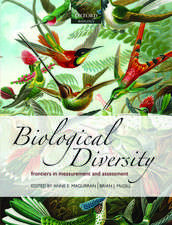The Biology of Biodiversity
Editat de M. Katoen Limba Engleză Paperback – 18 iul 2012
Preț: 893.71 lei
Preț vechi: 1089.89 lei
-18% Nou
Puncte Express: 1341
Preț estimativ în valută:
171.07€ • 185.88$ • 143.79£
171.07€ • 185.88$ • 143.79£
Carte tipărită la comandă
Livrare economică 21 aprilie-05 mai
Preluare comenzi: 021 569.72.76
Specificații
ISBN-13: 9784431659327
ISBN-10: 4431659323
Pagini: 340
Ilustrații: XII, 324 p.
Dimensiuni: 155 x 235 x 18 mm
Greutate: 0.52 kg
Ediția:Softcover reprint of the original 1st ed. 2000
Editura: Springer
Colecția Springer
Locul publicării:Tokyo, Japan
ISBN-10: 4431659323
Pagini: 340
Ilustrații: XII, 324 p.
Dimensiuni: 155 x 235 x 18 mm
Greutate: 0.52 kg
Ediția:Softcover reprint of the original 1st ed. 2000
Editura: Springer
Colecția Springer
Locul publicării:Tokyo, Japan
Public țintă
ResearchDescriere
Biological diversity, or biodiversity, refers to the universal attribute of all living organisms that each individual being is unique - that is, no two organisms are identical. The biology of biodiversity must include all the aspects of evolutionary and ecological sciences analyzing the origin, changes, and maintenance of the di versity of living organisms. Today biodiversity, which benefits human life in vari ous ways, is threatened by the expansion of human activities. Biological research in biodiversity contributes not only to understanding biodiversity itself but also to its conservation and utilization. The Biology of Biodiversity was the specialty area of the 1998 International Prize for Biology. The International Prize for Biology was established in 1985 in commemoration of the sixty-year reign of the Emperor Showa and his longtime devotion to biological research. The 1998 Prize was awarded to Professor Otto Thomas Solbrig, Harvard University, one of the authors of this book. In conjunction with the awarding of the International Prize for Biology, the 14th International Symposium with the theme of The Biology of Biodiversity was held in Hayama on the 9th and 10th of December 1998, with financial support by an international symposium grant from the Ministry of Education, Science, Sports and Culture of Japan. The invited speakers were chosen so as to cover four basic aspects of biodiversity: species diversity and phylogeny, ecological biodiversity, development and evolution, and genetic diversity of living organisms including human beings.
Cuprins
1 Species Diversity and Phylogeny.- 1. The Origin of Reproductive Isolation: Biological Mechanisms of Genetic Incompatibility.- 2. A Molecular Perspective on the Conservation of Diversity.- 3. Mitochondrial Molecular Clocks and the Origin of Euteleostean Biodiversity: Familial Radiation of Perciforms May Have Predated the Cretaceous/Tertiary Boundary.- 4. Molecular ?-Taxonomy of a Morphologically Simple Fern Asplenium nidus Complex from Mt. Halimun National Park, Indonesia.- 5. Adaptive Radiation, Dispersal, and Diversification of the Hawaiian Lobeliads.- 6. Phylogenetic Analyses of Large Data Sets: Approaches Using the Angiosperms.- 2 Ecological Biodiversity.- 7. The Theory and Practice of the Science of Biodiversity: A Personal Assessment.- 8. Biodiversity and Ecosystem Processes: Theory, Achievements and Future Directions.- 9. Creeping ‘Fruitless Falls’: Reproductive Failure in Heterostylous Plants in Fragmented Landscapes.- 10. Population Persistence and Community Diversity in a Naturally Patchy Landscape: Plants on Serpentine Soils.- 11. Patterns of Tree Species Diversity Among Tropical Rain Forests.- 12. Functional Differentiation and Positive Feedback Enhancing Plant Biodiversity.- 3 Development and Evolution.- 13. Developmental Genetics and the Diversity of Animal Form: Hox Genes in Arthropods.- 14. Developmental Mechanisms Underlying the Origin and Evolution of Chordates.- 15. The Regulation of Dorsiventral Symmetry in Plants.- 16. Evolution of Reproductive Organs in Vascular Plants.- 4 Genetic Biodiversity.- 17. Genetic Diversity of Color Vision in Primates.- 18. Avian Evolution During the Pleistocene in North America.- 19. Genetic Diversity of Human Populations in Eastern Asia.- 20. Human Diversity and Its History.
Caracteristici
Multidisciplinary approaches to biodiversity













